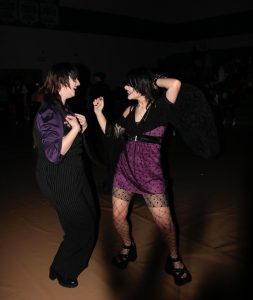Page 1: Now Presenting — Gender Expression
February 10, 2021
Sophomore Toby Ivy feels most confident in a graphic T-shirt, jeans and a pair of Converse. Throw in a jacket as an added touch, and the presentation is complete.
Ivy’s is a prime example of masculine gender expression.
“I would define gender expression as to how you express yourself; like how you act or how you dress,” Ivy said. “Gender expression is what you express out to other people or out in public but gender identity is what you identify as or what you were born as (male or female). Gender expression could be how you dress/act but gender identity is what you identify as. Like how some women identify as female and their gender expression is feminine.”
While femininity and masculinity are commonly associated with the two binary genders, there are people who identify as one of the binary genders and still choose to present a different way.
Senior Sierra Morgan prefers to present as androgynous, despite identifying as female.
“For me gender expression is how I like to present myself and it doesn’t necessarily correlate with my gender identity,” Morgan said. “Identity is for me how I prefer people to perceive me. I feel more comfortable presenting more androgynous because I feel uncomfortable with feminity, but I do identify more as female than male. I’ll present more feminine or masculine sometimes, but most of the time I dress very much in the middle.”
Senior Alivia Bolain feels the same way.
“Gender expression is how I feel through my clothes, however my identity is cig(gendered). I know I’m a woman, I just don’t like the way I look in women’s clothes,” Bolain said.
Freshman Megan Markstein uses any pronouns and usually presents feminine, though wishing to present more androgynous.
“I used to present very masculine, like, baggy clothes, I wouldn’t let my hair reach my neck,” Markstein said. “And in some ways, I guess I still do present that way, but I still embrace my feminine side, too.”
Pronouns are a big part of gender identity and expression.
“I identify as genderfluid, so from day to day, or week, my gender doesn’t feel right. Some days I would go by he/him, sometimes he/they, she/her, she/they, they/them. Recently, I’ve been experimenting with neopronouns,” junior Surrarie Hill said.
Neopronouns have been around since the 1300s when “ou” was a pronounced used interchangeably for he/him, she/her and they/them. Neopronouns today are a little different. Some use xe/xim while others use more unique pronouns to fit their gender identity.
“I use the neopronouns star/starself. You can use them in sentences, instead of saying ‘He is over there’ you would use ‘star is over there.’ Or ‘oh yeah, they’re all by themselves,’ you use ‘oh yeah, star is all by starselves’,” Ivy said.
Gender fluid and non binary are labels that people use when they feel as though their gender identity doesn’t fit in one specific place on the extremely wide gender spectrum.
All of these things can be confusing at first, but it’s not hard to be respectful to others.
“I wish more people knew to be more respectful. How a person dresses or presents or the pronouns that they use don’t directly affect you, and you shouldn’t act like they do. Just respect people and don’t be rude,” Morgan said.
The term gender expression refers to the way people express themselves and their gender identity through their style of dress and how they present themselves.
For some people it’s the way they dress, for others it’s the way they style their hair. Gender expression is different from gender identity, which is how a person identifies on the gender spectrum, which is also different from sex, which refers to the physical aspect of it.
Similar to neopronouns, they/them pronouns have been used singularly for hundreds of years. Singular they/them pronouns are used just like she/her or he/him, but with the same conjugations as the plural they/them.
Instead of saying “she went to the store,” you would say “they went to the store.” Rather than “his shoes are over there,” you would say “their shoes are over there.”








